Steemian Friends,
Today, I will write the lesson for week 04 of the Steemit Learning Challenge. I will discuss Industrial Automation(PLC) and Electrical Motor Faults with students this week. Industrial automation plays a huge part in the power sector. So, I will discuss the remaining part of industrial automation through the next three lessons, divided into three parts. I will discuss finding and solving electrical motor faults in the industrial sector for students. So, let's start without delay.
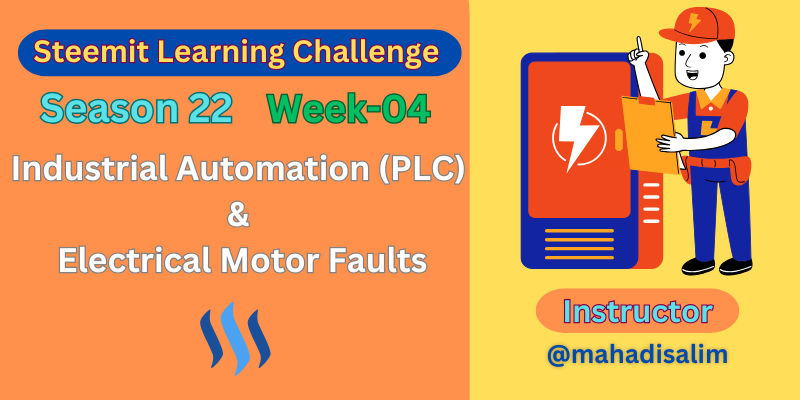
Design By Canva
Industrial Automation:
Industrial automation is an automated system in which manual work processes are automated through computer programming to increase work speed. The Industrial Revolution took place after the introduction of automation in the industrial sector. Due to automation, the production of goods has improved greatly in the industrial sector. Automation in the industrial sector covers a wide range. We cannot cover the entire process of industrial automation in one lesson. So today, we will learn about basic automation methods and automation hardware.
I will explain the industrial automation method in three parts.
- PLC (Programmable Logic Controller)
- VFD (Variable Frequency Drive)
- HMI (Human Machine Interface)
.png)
Design By Canva
PLC (Programmable Logic Controller):
PLC is the centre of industrial automation. It contains the computer programming language that operates the automation devices. We will program the automation control of electrical devices through PLC. There are different types of PLCs in the industrial sector. I have given the names of the PLCs of a few companies below.
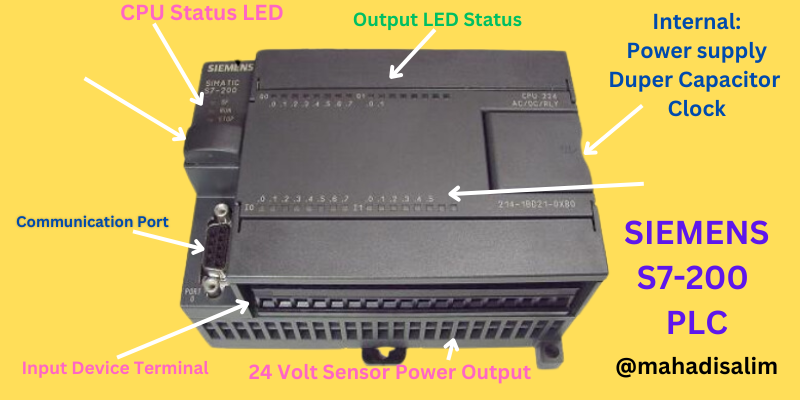
Design By Canva
- Siemens PLC
- Delta PLC
- OMRON/Mitsubishi PLC
- GE Fanuc PLC
I have used Siemens and Mitsubishi PLCs the most. Like a computer or mobile phone, a PLC has a model number. For example, Siemens' first PLC was LOGO PLC. Then, I got Siemens PLCs up to S7-200, S7-300, S7-400, S7-1200, and S7-1500 in the industrial sector. Each PLC has been updated by changing the model number to increase its ease of use.
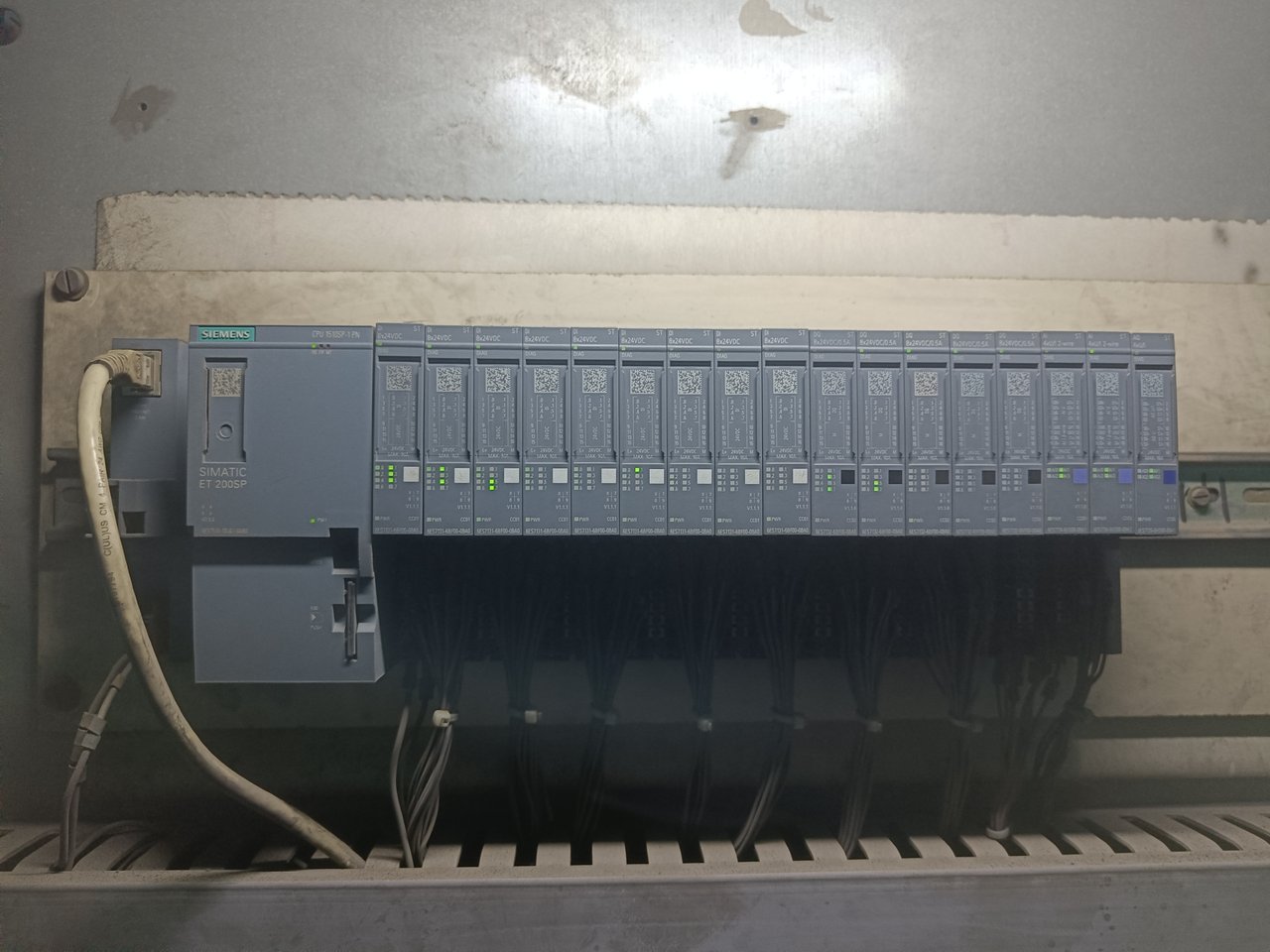
Siemens S7-200 PLC with module
Several models of S7-200 PLC are used, namely CPU 221, CPU 222, CPU 224 and CPU 226. The CPU 221 model had 10 I/O points. That means ten input and ten output devices can be connected through this PLC. When it was necessary to connect more input and output devices, Siemens brought another model PLC called CPU222. 14 input and output device connections could be made with the CPU 222 model. Thus, 24 input and output devices can be connected to CPU 224 and 40 with CPU 226. I hope you got the idea about Siemens S7-200 PLC.
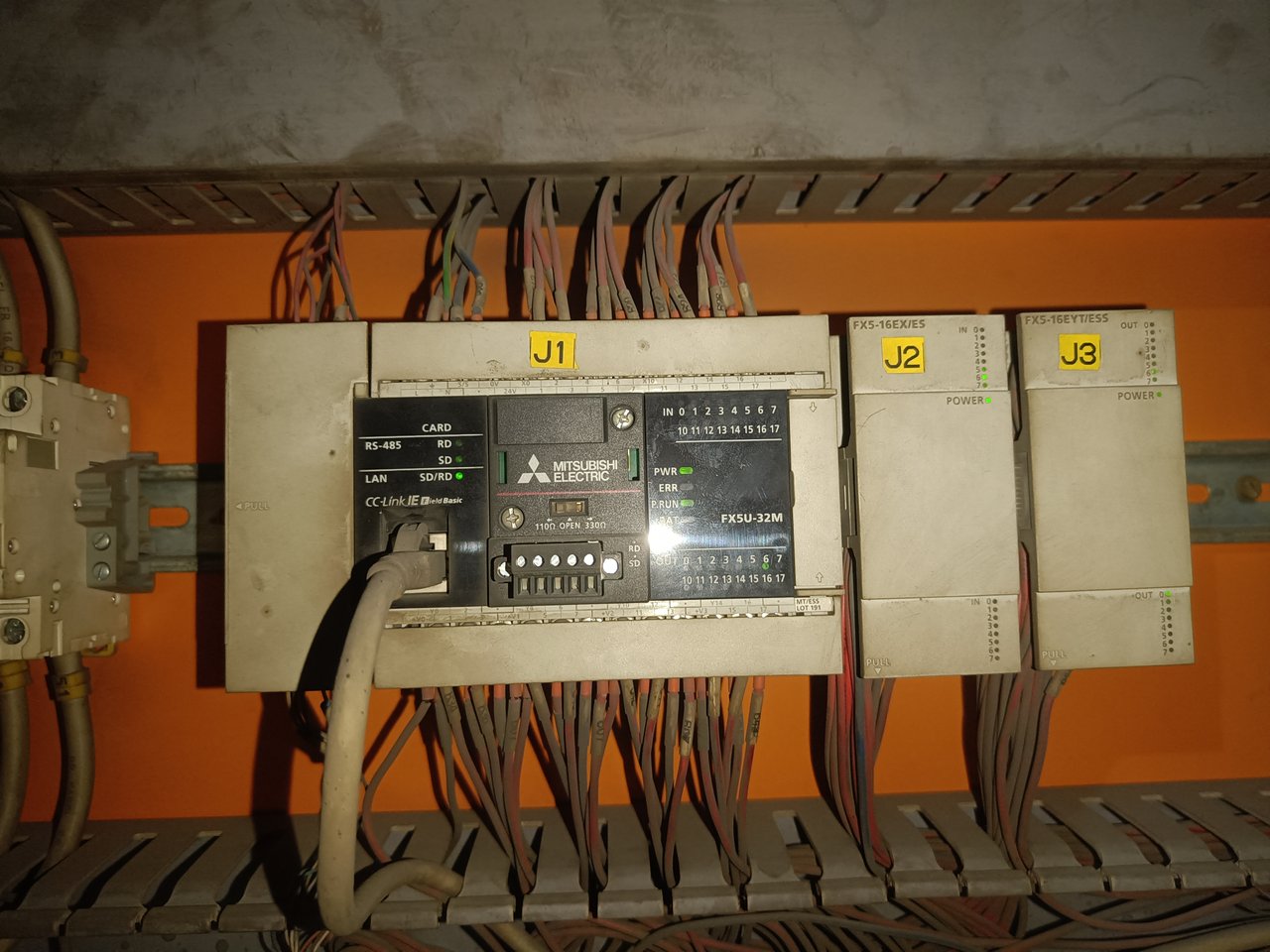
Mitsubishi PLC with module
Working Process of PLC:
I have shown the names of various parts of a Siemens S7-200 PLC above. We can understand the PLC only if we know its names and functions. First, we use a power supply to power up the PLC. The power supply is rated at 220/24 or 110/24 volts or 2 or 4 amperes. PLC manufacturing companies are rated according to the time of manufacture. However, there are very low voltage and low current ratings. We turn on the PLC with the power supply.
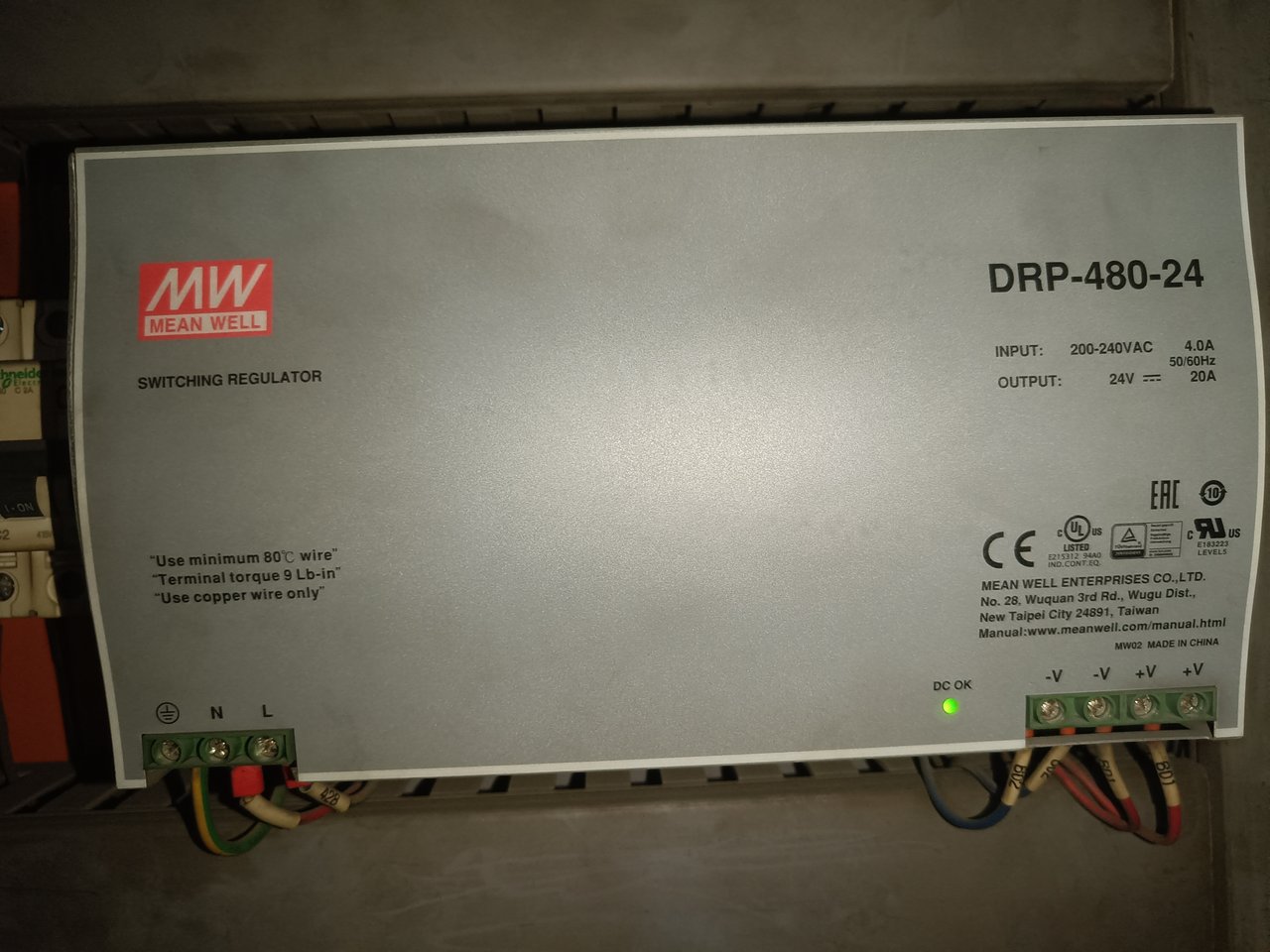
Mitsubishi PLC Power Supply or SMPS
.jpg)
Siemens PLC Power supply or SMPS
I/O Terminals:
There are I/O terminals, and depending on how many devices we will drive with a PLC, there are I/O terminals. The PLC is connected to the device through input and output terminals. If there is a PLC of 14 input and output devices, then we can operate 14 input and output devices with that PLC. PLCs have been updated over the years to eliminate the limitations of input and output devices. Input and output devices are based on voltage. For example, if an output device is switched on with 24 volts, then I have to connect that device to the 24-volt output of the PLC. I hope everyone understands.
To understand a PLC, you need to know about input and output terminals. Today, PLC companies use modules to overcome the limitations of input and output devices. If our input and output devices increase, we can connect additional input and output devices by connecting the module PLC with a data cable. Modules are based on input and output devices.
Communication Port:
Through programming, this port communicates a PLC with a computer, VFD, and HMI. The communication port is very important because the electrical equipment is operated by switching on and off the signal input and output from the PLC. This requires good-quality communication cables. The biggest problem while working with my PLC is a communication cable fault.
LED status: A PLC has a CPU LED, and the input and output devices have LED status signal lights. If you are a smart PLC operator, you can find the PLC fault by looking at the signal status.
Today, I will give you some input and output devices as examples. I will work with a sensor PLC. The sensor will count when a hot metal is in front of it. Before connecting the sensor to the PLC, I need to know two aspects. First, we must know whether the sensor is an input or output device. Second, we need to see the sensor's voltage. I hope everyone understands.
So, we first need to figure out the input and output devices. I have written details about these below.
Input device:
The device which sends a signal to PLC is called the input device. For example, a hot metal detector will send a signal to the PLC when a hot metal is in front of it. We can call a temperature-measuring sensor an output device. All the electrical devices that we will operate through the PLC must first take out the input and output devices and then connect them to the PLC. I hope everyone got to know the details about input and output devices.
Output Devices:
Devices to which signals are sent from the PLC are called output devices. For example, if a motor is turned on or off by a PLC, it will be an output device. We turn the motor on or off by sending a signal from the PLC. There are numerous such electrical devices that we operate with signals from PLCs.
PLC Module:
We have learned about PLC from different companies. A PLC has a fixed number of connectors called Digital Input (DI) and Digital Output (DO) to connect input and output devices. If the number of input and output devices increases, the entire PLC must be changed. Changing the entire PLC is very costly. Therefore, PLC companies use modules to connect additional input and output devices to the PLC, which are connected to the PLC via data cables. The picture shows the module connected to Siemens and Mitsubishi PLC.
Today, we will learn about some of the very important functions of industrial electrical engineering and discuss the electrical faults we face while working as electrical engineers or technicians in a product manufacturing company. There are some main faults in the power sector that you need to know about. Electrical faults should be found and resolved. I will teach you electrical fault finding and troubleshooting from my experience in electrical work. Read and learn today's lesson very carefully.
Finding out and solving motor faults:
We use different types of motors in our homes and offices to lift water or perform other necessary tasks. Suddenly, a water motor is unable to raise water. You hold down the electric switch, but the motor is not turning. Then, what you need to do is shown below, step by step.
First, you must check the motor, good and bad, with a multimeter. The selector switch of the multimeter should be set to the ohms range. The multimeter's red (positive) and black (negative) should be connected. Then you need to connect the positive and negative knobs of the multimeter. Then, check the result of the multimeter display. If the output of the multimeter is O/L, then the multimeter is good. I have shown a picture below.
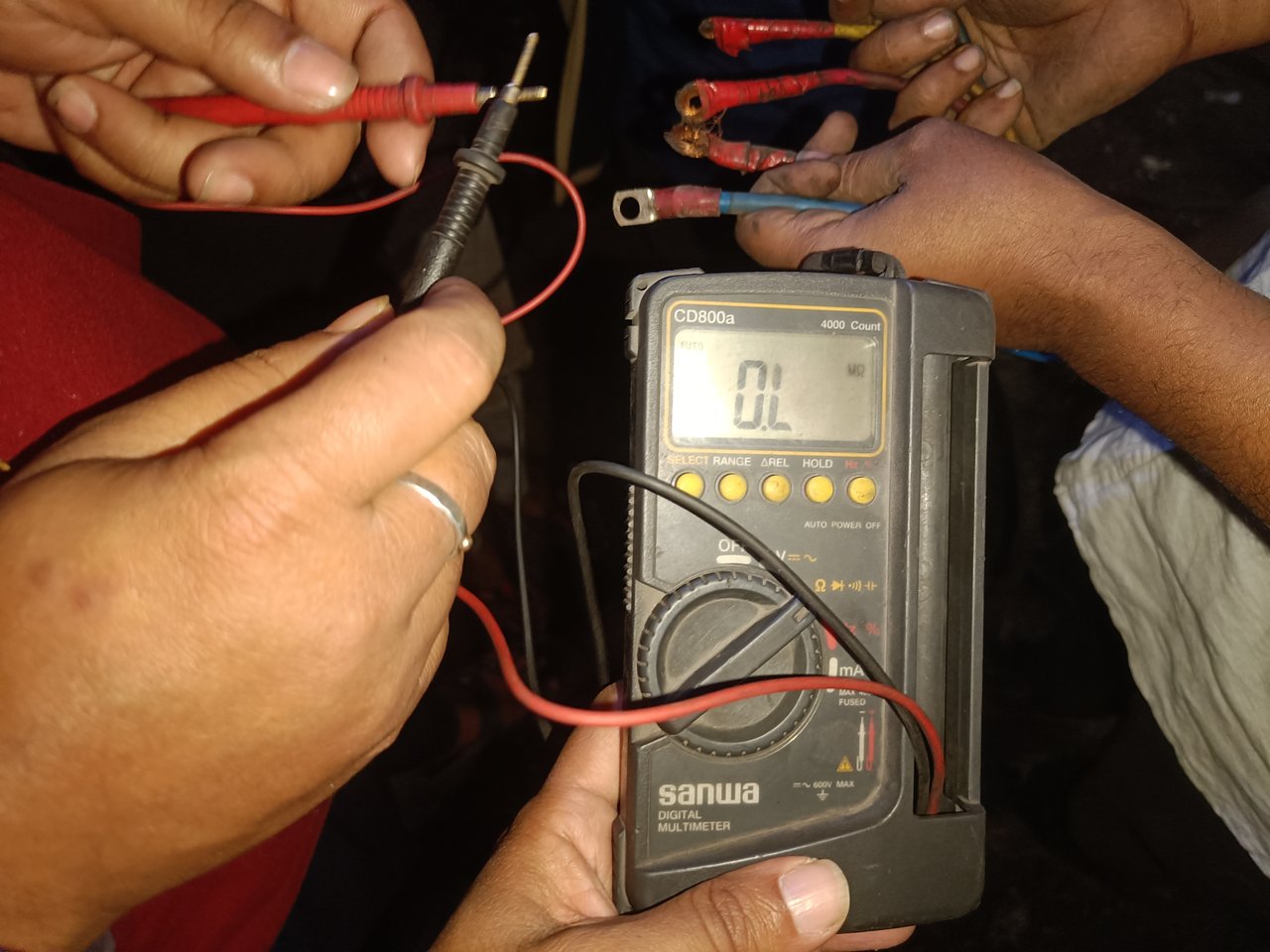
Multimeter Check
After checking your multimeter, disconnect the motor's incoming cable connection. I will now check a 25 HP submersible pump three-phase motor with a multimeter. Make the motor star-delta connection higher than the current motor rating. We have learned in previous lessons when to use a star delta starter. Now, we will check the motor by measuring with a multimeter at the cable end of the motor.
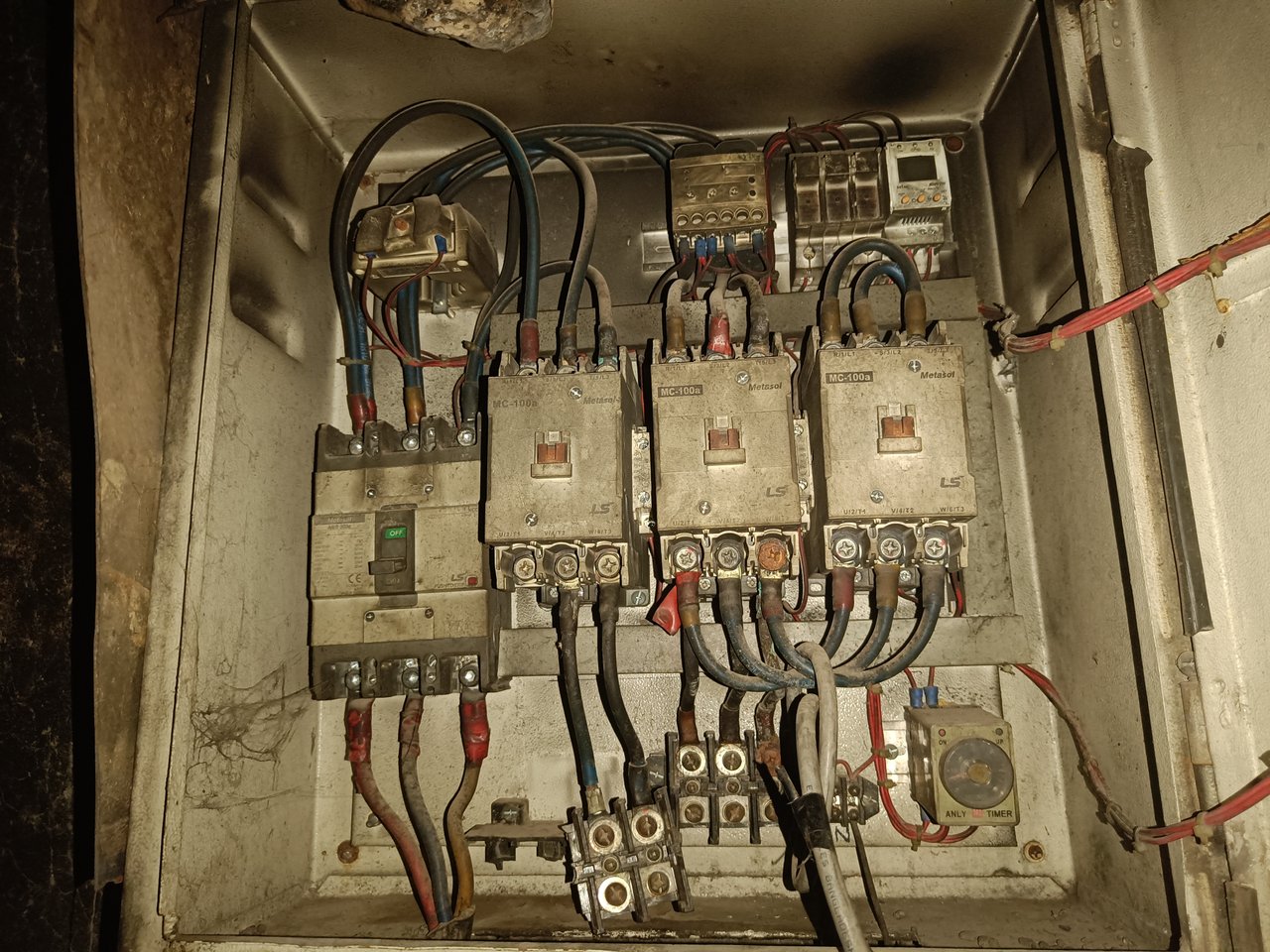
Pulling out the motor cable from the Star-Delta control panel
As we have seen in the previous lessons, there are six wires in total when the motor is connected in a star-delta connection. Three wires are used to start the motor in Star, and the remaining three are used to start the motor in Delta. The three cables are red, yellow, and blue, respectively. Below are the six cables I pulled from the motor's control panel.
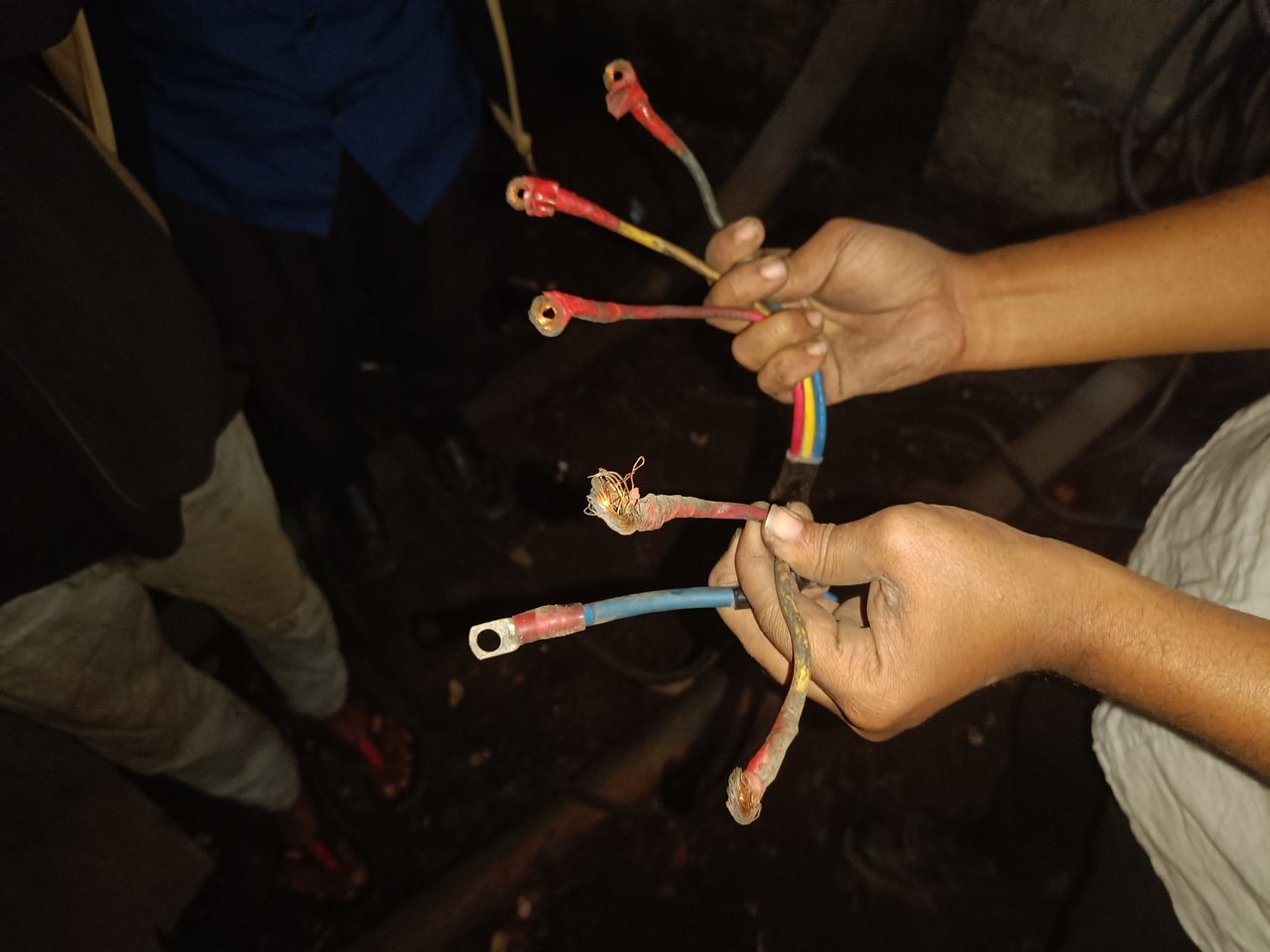
Several ends of the cable are kept separate
Then, I hold the positive and negative knobs of the multimeter to the two red cables. Then, I look at the output display of the multimeter. I see 13.30 Kilo-ohms at the output of the multimeter. If I could see 0 ohms in the output display of the multimeter, then I would understand the red phase of the motor. We got an output display of the multimeter with more than zero value, i.e. 13.30, so we know the red phase of the motor is bad. That means the motor is damaged. This way, we will check whether a three-phase motor is good or bad.
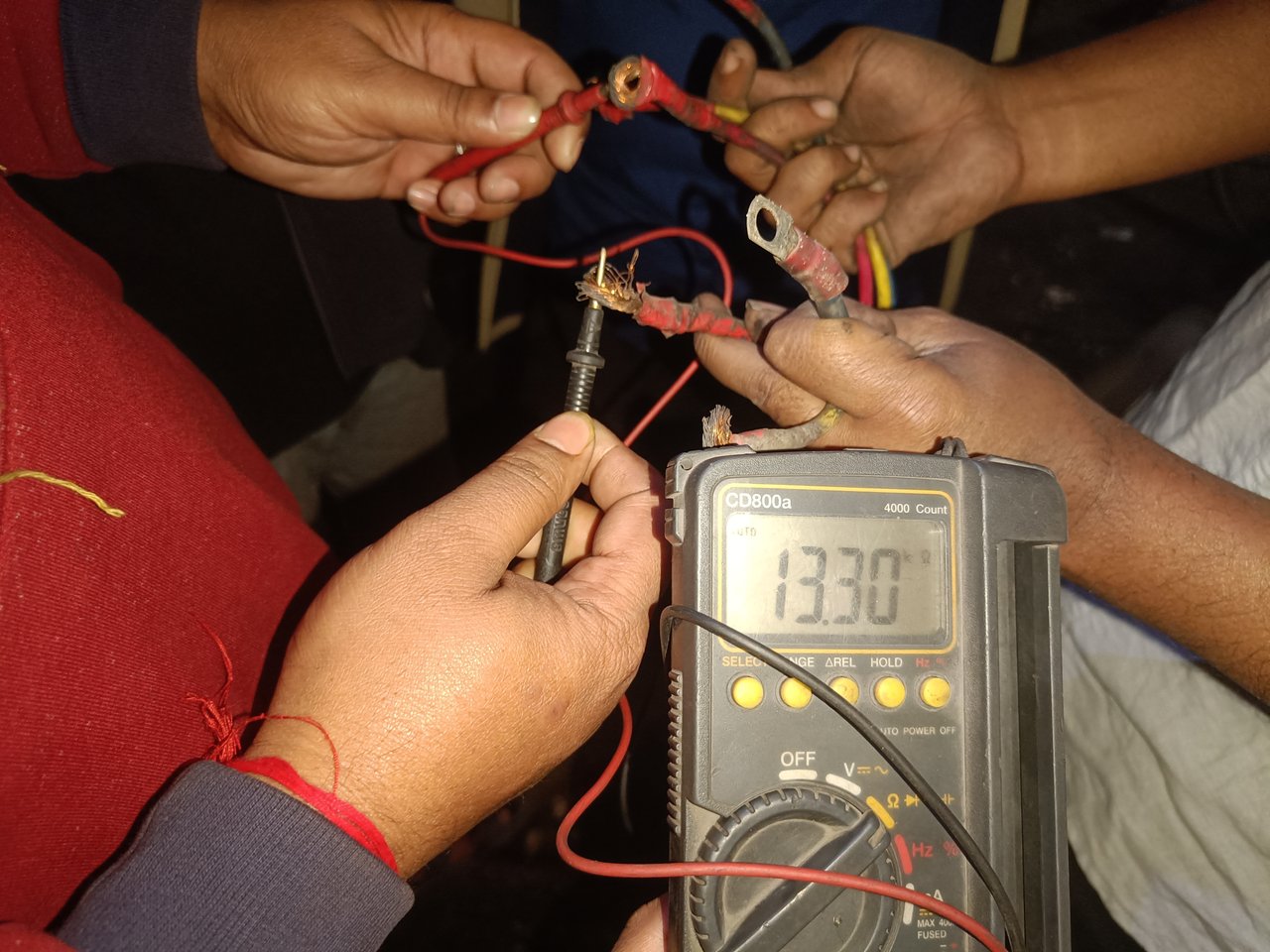
Two red cables are being checked
If I get a good check report of the red cable of the motor, then I have to check the yellow cable with a multimeter. I hold the knobs of the multimeter to the ends of the two yellow wires. I see 11.77 Kilohms in the multimeter output display. If our motor phase value is 0 ohms, we assume it is good. But I see 11.77 Kio-ohms on the multimeter, and taking the yellow phase, it is bad, i.e., the motor is bad.
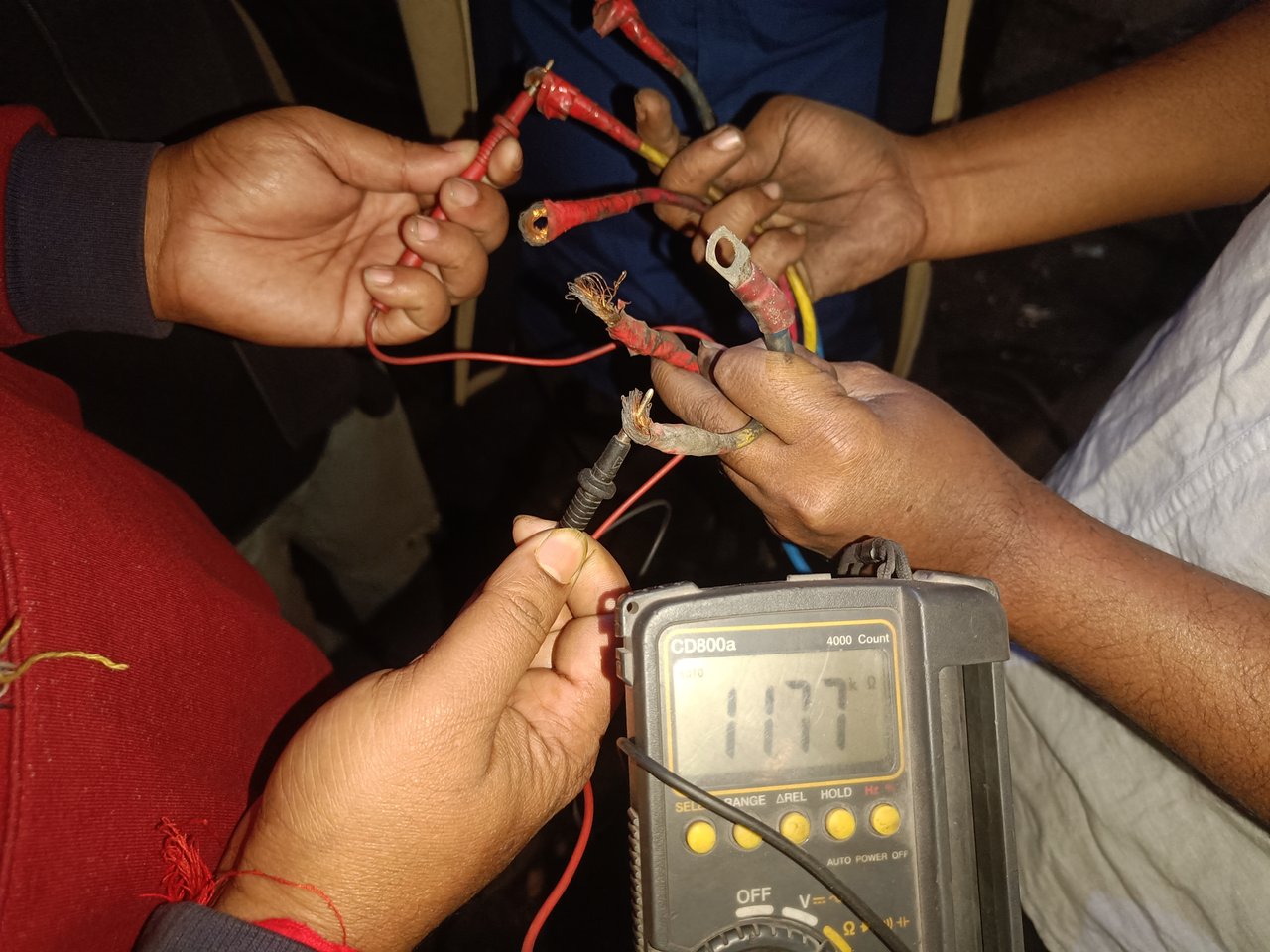
Two yellow cables are being checked
Then, I connect the knob of the multimeter to the two blue-coloured cables. Looking at the output display of the multimeter, the blue cable shows 30.05 kiloohms. So, I will assume the motor is also broken in this case. It is shown in the picture below.
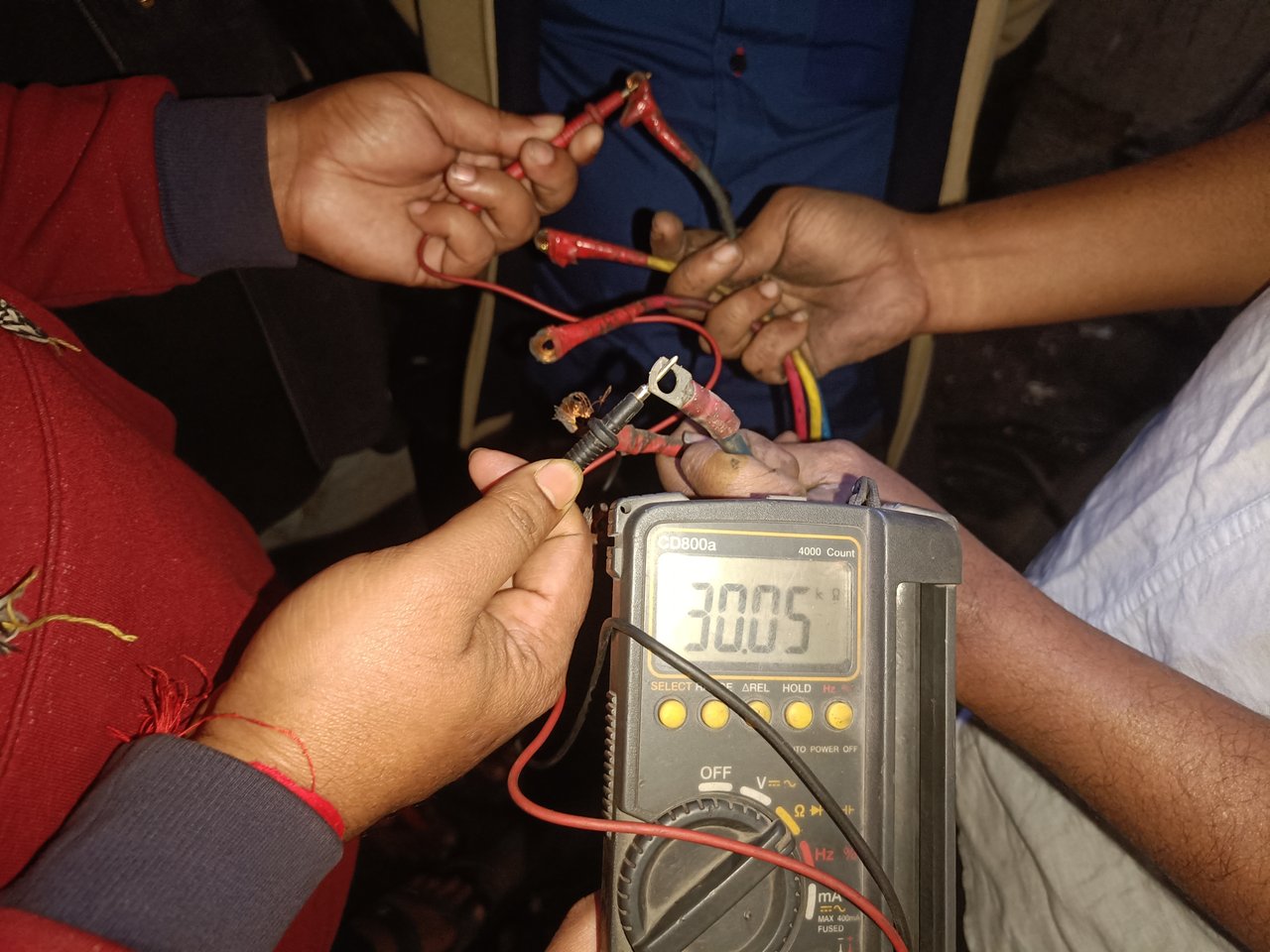
Two blue cables are being checked
I have shown a table chart below by which we can understand the good or bad of the motor.
| Connection of knob of multimeter with cable | Good Meter Value | Bad Meter Value |
|---|---|---|
| Red to Red | 0-10 Ohms | Kiloohms to infinity |
| Yellow to Yellow | 0-10 Ohms | Kiloohms to infinity |
| Blue to Blue | 0-10 Ohms | Kiloohms to infinity |
The above motor is a submersible pump motor located deep in the ground. Since this type of motor is deep in the ground, we checked it with a multimeter through the cable.
We will learn to check the motor with a multimeter from the motor's connection terminal. We will open the terminal box and check the motors within our reach. I have posted two learning parts on the Steemit platform about the method of opening the motor's terminal box and checking it with a multimeter. Today, I am sharing the link for two lessons. You will learn it by reading my post. Let me know if there is any problem to understand in the comments section.

Taking screenshots from lessons

Taking screenshots from lessons
To run a 25 KW three-phase motor, the following procedures should be followed:
The motor is more than 5 kW, so a star-delta connection will be required.
The current of the motor should be taken out. We have learned the rules for extracting current in previous lessons. So today, I took out 43 amps of direct motor current today. Current, I = P/√3 V power factor(0.8) by formula.
Now, I will buy the necessary materials for the Star Delta starter connection, considering the motor's current of 43 amperes.
| Material Name | Quantity | Ratings |
|---|---|---|
| Magnetic Contactor | 3 Pcs | 85 A |
| MCCB | 1 Pcs | 100 A |
| Overload | 1 Pcs | (0-60)A |
| Timer | 1 Pcs | (0-60)S |
- Magnetic contact 3 of 85 amperes. Since the motor's current is 43 amperes, we will put the magnetic contacts at almost twice the current because the starting current is very high when starting the motor. These are very important things.
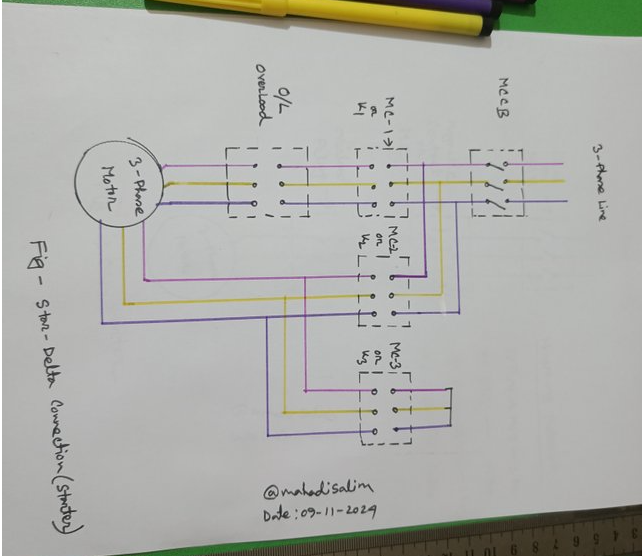
Taking screenshots from lessons
A. What do you understand by industrial automation?
B. Write about the importance of industrial automation during the Industrial Revolution.
C. Write the names and operations of various parts of a PLC with a picture.
D. Name five input and output electrical and electronics devices operated by PLC.
E. Practical:
The power load for setting up an industry is assumed to be 10 MW. Five 5 kW and three 45 kW three-phase motors will be used in the production of the product. You are an electrician or electrical engineer in that company. Perform the following electrical works with responsibility:
The incoming electrical line in the industrial area is 11 KV. Prepare a transformer specification by first calculating the load.
Draw the starter (power circuit) for running a 5 kW three-phase motor and write the required materials.
Draw the starter (power circuit) for running a 45 kW three-phase motor and write the necessary materials.
A 15 kW motor will keep the product in a fixed location. The motor must run in both directions. Draw the motor's power circuit and write down the materials required for making the circuit.
F. Review the pictures of the motor checked with a multimeter in my lesson and write your opinion in your own words.
If the result of checking the motor seems good to you, then present your reasoning.
If you think the motor is bad, explain how you know it is bad.
[Note: Since practical work with a three-phase motor will not be possible for everyone, you have to draw the connection terminal of the motor and show it.]
Marks Distribution:
| Sl. No | Marks |
|---|---|
| A | 0.5 Mark |
| B | 1 Mark |
| C | 1.5 Marks |
| D | 1 Mark |
| E | 4 Marks |
| F | 2 Marks |
Today's lesson completed the topics of transformers and motors in the industrial sector. I hope you have learned about how motors and transformers work in the industrial electrical sector. If students complete the practicals of today's lesson, they can work in industrial electrical.
- Your title should be "Industrial Automation(PLC) and Electrical Motor Faults."
- The content must be #steemexclusive.
- The article must contain the tag #electricity-s22w4.
- Plagiarism is not allowed.
- The link of your task must be added in the comments of this publication.
- Use the burnsteem25 tag only if you have set the 25% payout to @null.
- You can publish homework in any community and in any language. But don't forget to use the original tag.
- Invite three of your active Steemian friends.
- The participation schedule is between Monday, January 06, 2025, at 00:00 UTC to Sunday, - January 12, 2025, at 23:59 UTC.
SC01/SC02 would check on the entire 15 participating Teaching Teams and Challengers and upvote outstanding content. Upvotes are not guaranteed for all articles.
At the end of the week, we would nominate the top 4 users who had performed well in the contest and would be eligible for votes from SC01/SC02.

Best Regards,
Industrial Electrical Instructor
@mahadisalim



